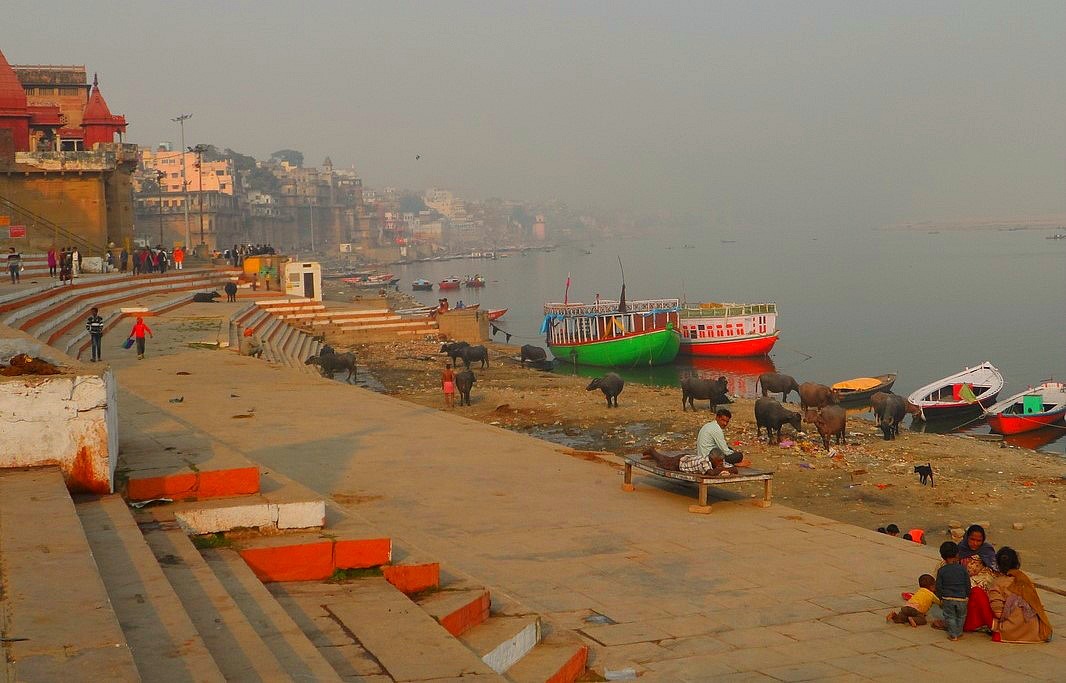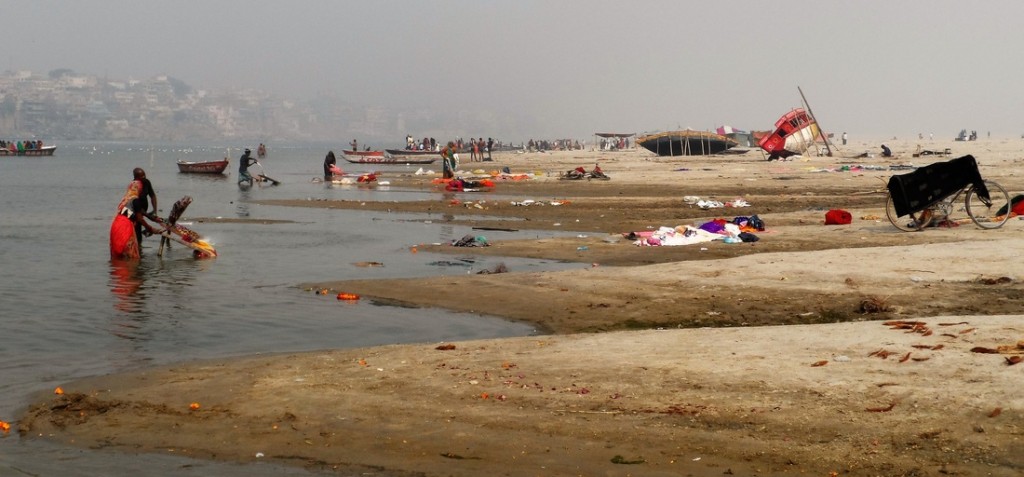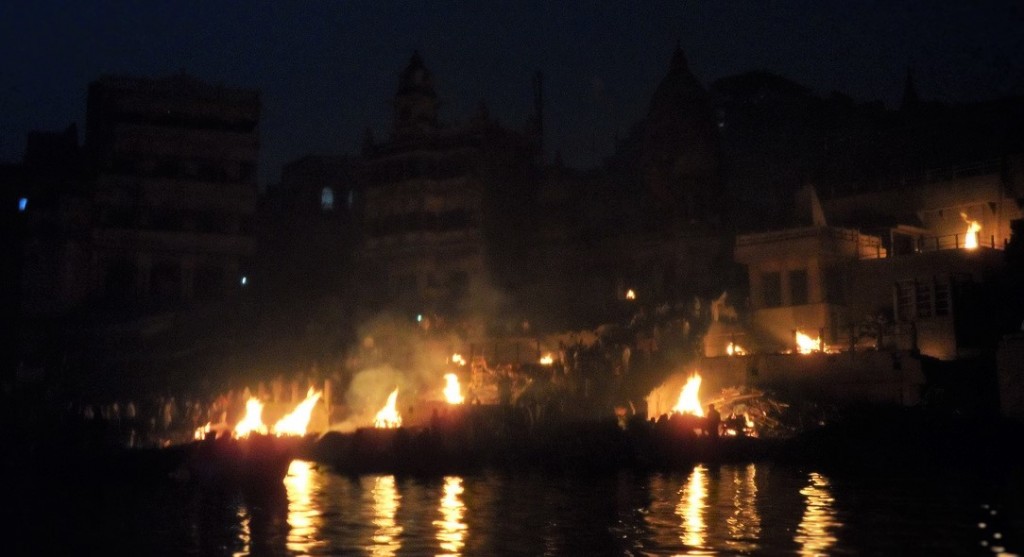
Sometimes, as you travel the winding roads of life — slowly, then speeding up, navigating the curves and bumps you meet along the way — you find yourself stopped, halted suddenly in just the place you need to be.
I believe firmly that all we encounter in life — from the challenges of finding yourself, to the elation of being in love or discovering a new beautiful place, to the calm reflective moments spent alone — is leading us to a greater understanding, not only of ourselves, but of our world and the time we’re given to spend here.
I met one of these well-placed moments head-on as I was nearing the end of a three-week journey in India. (Three weeks is not nearly enough time to explore such an incredibly diverse, chaotic, and utterly fascinating place, but three weeks is what I had.)
It had been a tough year for me. A few months after I’d returned home from teaching abroad in Thailand, in the midst of reverse culture shock, I lost my father to an illness he’d been diagnosed with less than six months before. A couple months later, my boyfriend broke up with me, which probably was for my own good as I wasn’t really happy back in the United States, but it still hurt… a lot.
These experiences are not unique, but piled up on top of each other they dulled the fire in my soul, and had left me feeling in shadow.
But then I was far away from all of that, in India. Along with two travel friends, we made the most of our time, pacing ourselves maybe more quickly than I’d have liked, moving on as soon as we’d gotten our bearings in each new destination, which often meant hopping on an overnight bus every couple of days. It was winter and the buses were cold, comically bumpy (my friend even changed out of her normal bra into a sports bra behind the privacy curtain of our compartment on one bus!), and bathroom breaks consisted of stopping in the middle of the night and finding privacy on the side of the road wherever you could, in an alley, perhaps behind a cow.
During our first two weeks, we’d wandered the busy, seedy streets of New Delhi, making our way next by train to the state of Rajasthan, starting in the capital Jaipur, where we did a lot of walking, traipsing through impressive palaces and forts nestled up in the mountains. From there, we decided last-minute to go camel trekking and spend one magical night in the desert of Jaisalmer, wrapping ourselves in heavy blankets, stargazing in awe at the sky near the Pakistani border, before heading to picturesque Udaipur, the city of lakes, where we rested up for three days and rang in the new year with a group of travellers at our hostel.
It was now the beginning of January, and after a 15-hour, dark, and somewhat claustrophobic and smelly train ride, plus a quick stop in Agra to see the Taj Mahal, followed by another overnight bus, we made it to sacred city of Varanasi, located on the holy Ganges river.

There is equal parts life and death along the Ganges | Photo by Cati Vanden Breul
Like I do with most things, I had left the unfolding of much of the trip up to chance, but Varanasi was somewhere I knew I wanted to see. I knew it was considered by many to be the spiritual capital of India. I knew life there revolved around the Ganges and that Hindus from all over India, and visitors from around the world, would come to bathe in its healing waters, to shed the stain of sin from their bodies, or even to die there, as a means of escaping a never-ending karmic cycle of life and death.
I’d heard it was full of temples, full of gurus, full of colour, full of ritual.
I’d heard of the ghats, the places along the riverfront where all of it came together.
But I didn’t know what to expect.
When we arrived, we dropped our bags at our hostel, and after a vital nap, headed on foot to the ghats. Walking in India is at best, hilarious, and at worst, perilous. The uneven streets are jammed with bodies, cattle, food stalls, and honking things that move — from bicycles, to auto- or cycle-rickshaws, to taxis, to motorbikes — all fighting for the best position in the road. In this constant circus, you might be inclined to keep your eyes on the ground to avoid stepping in excrement or a suspicious puddle, but if you do that you open yourself up to a collision with any of the above vehicles, or cows, which will not stop for little old you trying to make your way somewhere.
Though those walks can be their own stand-alone adventure of sorts, by this point in the trip I was usually happy to just arrive at wherever I was going and step away from the throng.
In fact, the moment we left the main drag, took a left towards the river, and made our way through a maze of winding side streets to the ghats, I felt a calming sense of anticipation. I’d been feeling worn out the last few days, travel-weary, a little sick to my stomach, and cold and dirty from the lack of a hot shower.
Eventually, after passing numerous hole-in-the-wall shops selling incense, figurines, oils, you name it, we reached a staircase leading down to the Ganges. All those feelings of weariness dissolved, and I was immediately re-energised.
It looked unreal. The river was shrouded in haze, and had a mystical appearance. Staircases stretched in both directions as far you could see, leading from colourful, surreal building structures to the water — these were the ghats.
I was in awe, and was struck by an urge to just wander aimlessly along the water’s edge for hours, soaking in all the sights around me.

Daily life can be found along the ghats | Photo by Cati Vanden Breul
There was a welcome absence of motorised vehicles, but the sensory overload was still there, albeit in a less overwhelming way. Here the cacophony was purely… intriguing.
Each ghat seemed to have its own purpose — some staircases were covered in bright laundry drying in the sun, others led to hotels and rooftop restaurants boasting views of the Ganges, others seemed to be designated for stretching or bathing, where bathers, young and old, splashed water on themselves nearly naked, without shame, covered only in thin strips of cloth, saris, or at times, nothing.
Then, as we continued to walk amid the peaceful chaos, we saw plumes of black smoke, pyres of burning orange embers, huge stacks of lumber, and lots of men standing around watching at least a dozen flaming heaps just inches from the water.
I’d heard of the Hindu burning ceremonies here, where the dead achieve moksha, a liberation from the cycle of rebirth, entering a state of bliss after being cremated on the banks of the river.
I’d heard of it, and thought we might see it, but didn’t realise it was a process that went on 24-hours a day in Varanasi, the only place in India where the ceremony of release is non-stop. I thought it would maybe be in a small designated area, on a far-off bank, maybe reached by boat. Something that you would look at from afar, and never see up close. I didn’t realise it would be right there, for all to see.
We stopped, unsure whether we should avert our eyes and walk quickly by, or if it was okay to take it in for a moment. Our being there didn’t really feel disrespectful, and no one paid us any mind at all really. It felt simply like we were a part of the moment, paying our respects tacitly to the strangers who had departed their bodies, bodies that their family members had brought on a journey to the Ganges for a somber, yet equally joyous, send off to nirvana.
Honestly, words fail to describe what I was experiencing in that moment. I felt rooted to the earth, and was overtaken, briefly, by a sudden intense jolt of emotion. Primal. Grounding. Sorrowful. Calm.
In two days, it would be the one-year anniversary of my father’s death. I had been thinking about him a lot lately. Seeing his face in bearded elderly men, peacefully sitting by the river. Talking to my friends about him, grateful that they were kind enough to listen, though they’d never met him.
He wasn’t Indian. He wasn’t Hindu. He’d never been to the Ganges. He didn’t get to do as much travelling as he would have liked. I think he felt stuck a lot of the time, especially at the end, when time ran out much too quickly. He would have been fascinated by India. We could have talked about it. I wanted to tell him about all I’d seen. He always seemed so proud of me, and accepting of my constant need for movement. Sad that it meant I was away for years at a time, but so happy I was able to see more of the world. His sweet girl, his world traveller, he called me.
I thought of the day we said goodbye. He was unconscious in his hospital bed, so I did the talking. I talked about memories of him holding my hand walking me to elementary school, of playing marbles together on a woven rug — in the house he had lived in for more than 30 years, of eating snacks together and his special chicken noodle soup. How we had made a pot of it together, less than two months before he died, when he still had the energy.
I remembered, after the nurse had unplugged his body from the machines, watching his breathing slow, the rise and fall of his chest becoming ever less frequent, until it stopped. I could sense, quite clearly, that he had left his shell.
Later, I requested to be alone with him in the room, unsure of what I wanted to say, but knowing I wanted to say something. I could feel that he wasn’t in that body anymore, his essence was elsewhere. I hugged him anyway, kissed his forehead, said the words that tumbled out. From now on, he was going to be a memory, and I was going to carry him with me.
I left the room, and that would be the last time I’d see him in human form. He was cremated, but unlike in India, it was behind closed doors.

The night burning along the Ganges| Photo by Cati Vanden Breul
Watching the ceremony now, public and shared between many bodies, I thought of where he might be. Did he have an idea of where I was? Standing here, trying to include him in some way, using my own eyes, to this moving display in front of me.
What I was witnessing wasn’t sadness. It wasn’t grief. It wasn’t even, surprisingly, overly shocking to see. It was, to me, a ritual of hope, of honour, of an ultimate respect for life.
I felt gratitude for the way we had come upon this sacred procedure. It would have felt different had we sought it out directly, went in with expectations.
That night, we took a sunset boat tour of the river, each of us letting go of a candle into the water, saying our family name for luck as instructed by the friendly man rowing us. There were dozens of boats in the water filled with Indians and tourists alike, a scene repeated each night.
There was methodical chanting, drumming, and dancing happening on one of the main ghats, sounds that filled the air. The scent of incense was overpowering as most of the boats floated in stillness, hundreds of people watching this visceral exhibition together.
Afterwards, our rower paddled our wooden boat further along amidst the others.
He was taking us towards the burning.
The sky above us was pitch black now, and the blazing orange bonfires continued as eternal lights in the dark, reflecting off the water, casting the mourners and stockpiles of wood into illuminated shadow.